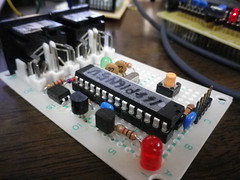
|
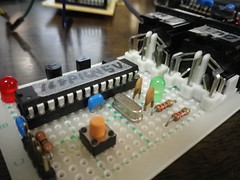
|
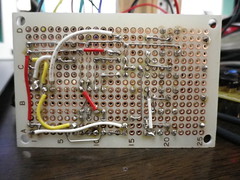
|

|

|

|
void setup() {
Serial.begin(31250);
}
void loop() {
int readdata = Serial.read();
if(readdata != -1) {
Serial.write(readdata);
}
}
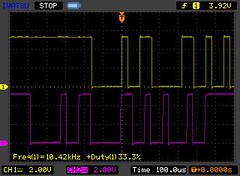
#include <TimerOne.h>
int ledPin = 13; // LED connected to digital pin 13
char laststat = 0;
int tempo = 100;
int curclock;
int timebase = 120;
void setup() {
long oneclock;
Serial.begin(31250);
sendMidi(0xb0, 0x78, 0); // all sound off
Timer1.initialize();
oneclock = 60 * 1000L * 1000L / (tempo * timebase);
curclock = 0;
Timer1.attachInterrupt(timertask, oneclock);
}
void loop() {
digitalWrite(ledPin, HIGH); // sets the LED on
delay(1000); // waits for a second
digitalWrite(ledPin, LOW); // sets the LED off
delay(1000); // waits for a second
}
void sendMidi(char stat, char data1, char data2) {
// running status
if(laststat != stat) {
Serial.print(stat, BYTE);
laststat = stat;
}
Serial.print(data1, BYTE);
Serial.print(data2, BYTE);
}
void timertask () {
if(curclock == 0) {
sendMidi(0x99, 60, 100); // note on
}
else if(curclock == 110) {
sendMidi(0x99, 60, 0); // note off
}
++curclock;
if(curclock == timebase)
curclock = 0;
}
四分音符をならすスケッチ其の弐
#include <TimerOne.h>
int ledPin = 13; // LED connected to digital pin 13
char laststat = 0;
int tempo = 100;
int curclock;
int timebase = 120;
long clocktime;
void setup() {
long oneclock;
Serial.begin(31250);
sendMidi(0xb0, 0x78, 0); // all sound off
Timer1.initialize();
oneclock = 400L;
curclock = 0;
clocktime = (1000000L * 60 / (timebase * tempo)) / oneclock;
Timer1.attachInterrupt(timertask, oneclock);
}
void loop() {
digitalWrite(ledPin, HIGH); // sets the LED on
delay(1000); // waits for a second
digitalWrite(ledPin, LOW); // sets the LED off
delay(1000); // waits for a second
}
void sendMidi(char stat, char data1, char data2) {
Serial.print(stat, BYTE);
Serial.print(data1, BYTE);
Serial.print(data2, BYTE);
}
void timertask () {
if(curclock == 0) {
Serial.print(0x99, BYTE);
} else if(curclock == 1) {
Serial.print(60, BYTE);
} else if(curclock == 2) {
Serial.print(100, BYTE);
} else if(curclock == clocktime * 110) {
Serial.print(60, BYTE);
} else if(curclock == clocktime * 110 + 1) {
Serial.print(0, BYTE);
}
++curclock;
if(curclock == timebase * clocktime)
curclock = 0;
}
四分音符をならすスケッチ其の参
#include <TimerOne.h>
#define MIDI_BAUD_RATE 31250
int ledPin = 13; // LED connected to digital pin 13
int tempo = 100;
int curclock;
int timebase = 120;
int txremain;
int txcurrent;
unsigned char txqueue[8];
ISR(USART_TX_vect)
{
if(txcurrent < txremain) {
UDR0 = txqueue[txcurrent];
++txcurrent;
}
}
void setup() {
long oneclock;
Timer1.initialize();
oneclock = 60 * 1000L * 1000L / (tempo * timebase);
curclock = 0;
Timer1.attachInterrupt(timertask, oneclock);
txcurrent = 0;
txremain = 0;
UBRR0H = ((F_CPU / 16 + MIDI_BAUD_RATE / 2) / MIDI_BAUD_RATE - 1) >> 8;
UBRR0L = ((F_CPU / 16 + MIDI_BAUD_RATE / 2) / MIDI_BAUD_RATE - 1);
UCSR0B |= _BV(TXEN0);
UCSR0B |= _BV(TXCIE0);
}
void loop() {
digitalWrite(ledPin, HIGH); // sets the LED on
delay(1000); // waits for a second
digitalWrite(ledPin, LOW); // sets the LED off
delay(1000); // waits for a second
}
void sentnoteon()
{
txqueue[0] = 60;
txqueue[1] = 100;
txcurrent = 0;
txremain = 2;
UDR0 = 0x99;
}
void sentnoteoff()
{
txqueue[0] = 60;
txqueue[1] = 0;
txcurrent = 0;
txremain = 2;
UDR0 = 0x99;
}
void timertask () {
if(curclock == 0) {
sentnoteon();
} else if(curclock == 110) {
sentnoteoff();
}
++curclock;
if(curclock == timebase)
curclock = 0;
}
30年前にPC98用に作ったMIDI/FM音源ボードにATMEGA328Pをのっけて使えるように しました。SSG/OPN/OPL/MIDI OUTは確認しました。MIDI INは割り込みが無いと 厳しいので確認していません。PC98用なのにユニバーサル基板な訳は、当時PC98用の 専用基板は高かったので、専用基板にユニバーサル基板のっけて使っていたためです。
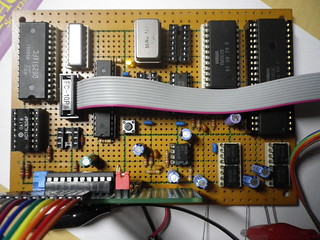
もともとあったデータバスとWR,RD,A0はそのままつなぎ、CSはアドレスデコーダーを バラして74LS138だけにしてA0,A1,A2をつなぎ、E3をRESETにしてみた。通常はA0,A1,A2 をHとしてO6がLになっているが、使わないので問題ない。
当初はISPの5Vで駆動していたが、オペアンプの電源が必要なため昇圧も考えたが、 ノイズが心配なので、12-15Vのアダプタを使う事にして5V/500mAのレギュレータを 裏面に貼付けてみた。
ATMEGA328Pは外部水晶の16MHz駆動とした。この基板は発振回路が3つもある。ちゃんと 設計したら、一つでどうにかなりそうなのだが。
デバッグに利用するためにI2Cを出してATtiny2313を使ったLCD表示モジュールを つないでみた。
フルの電流を計ってみたら200mAくらいのようだ。